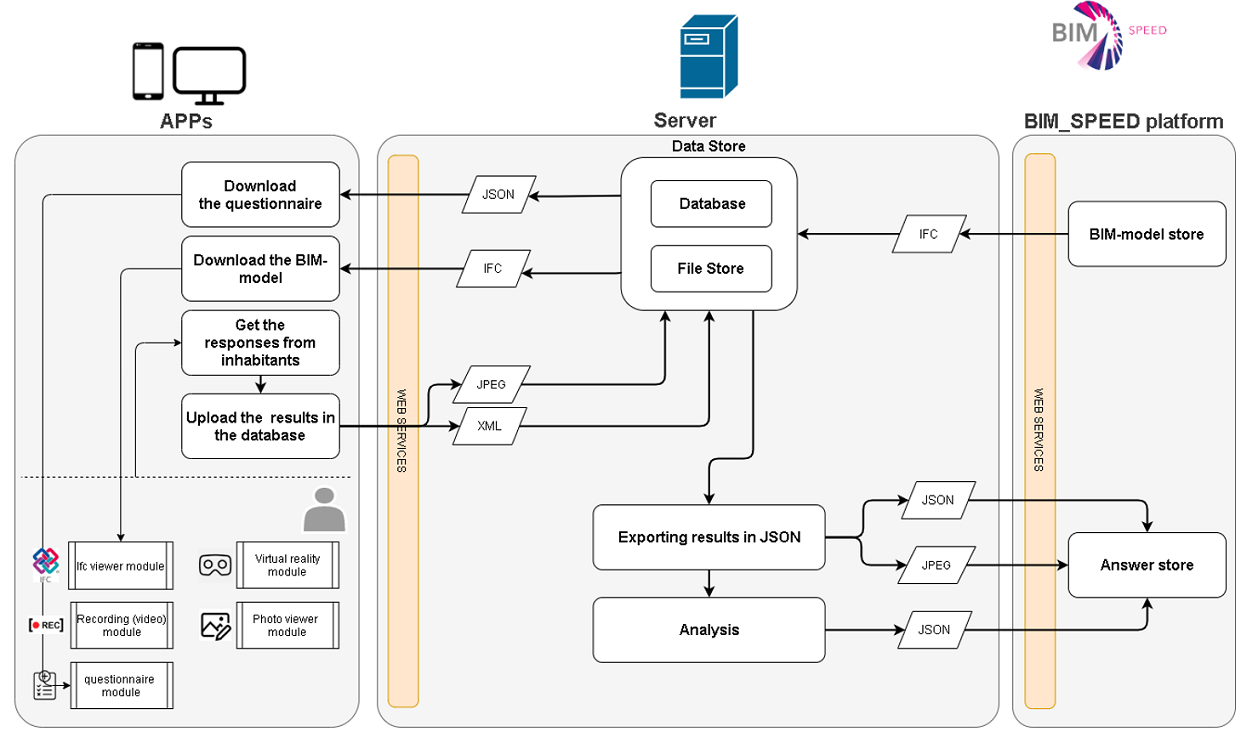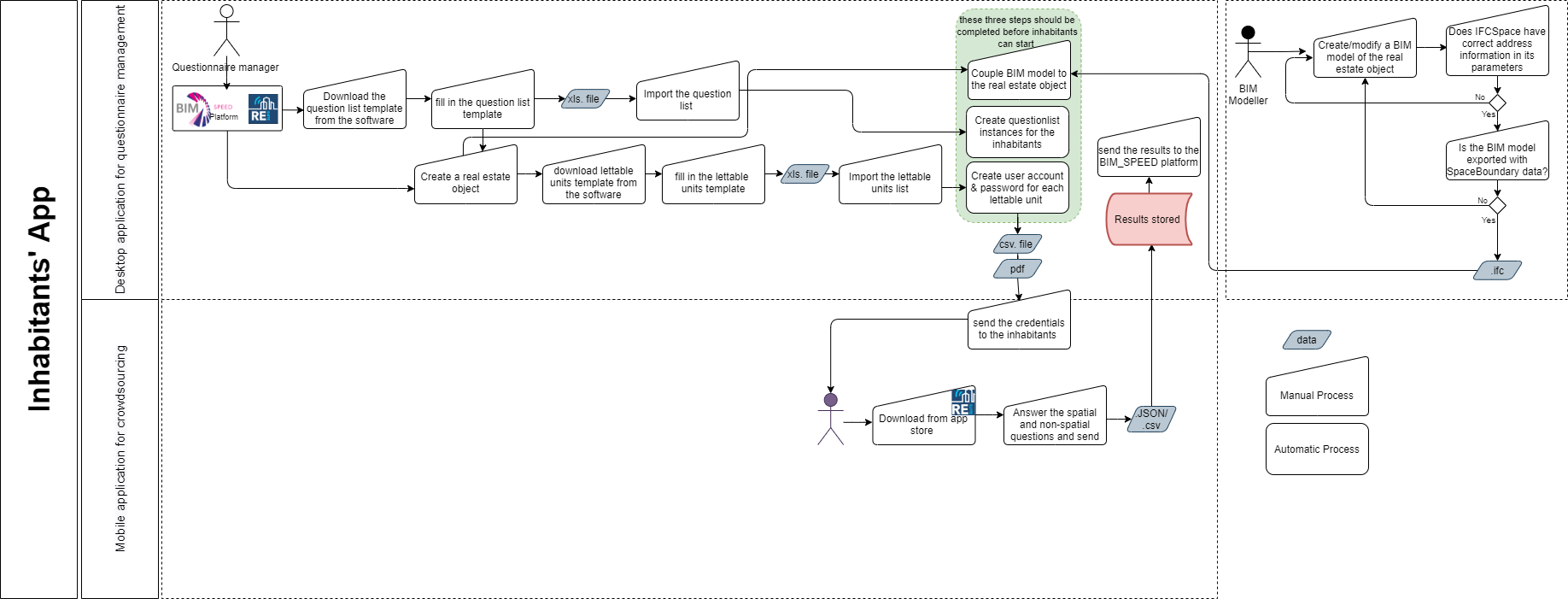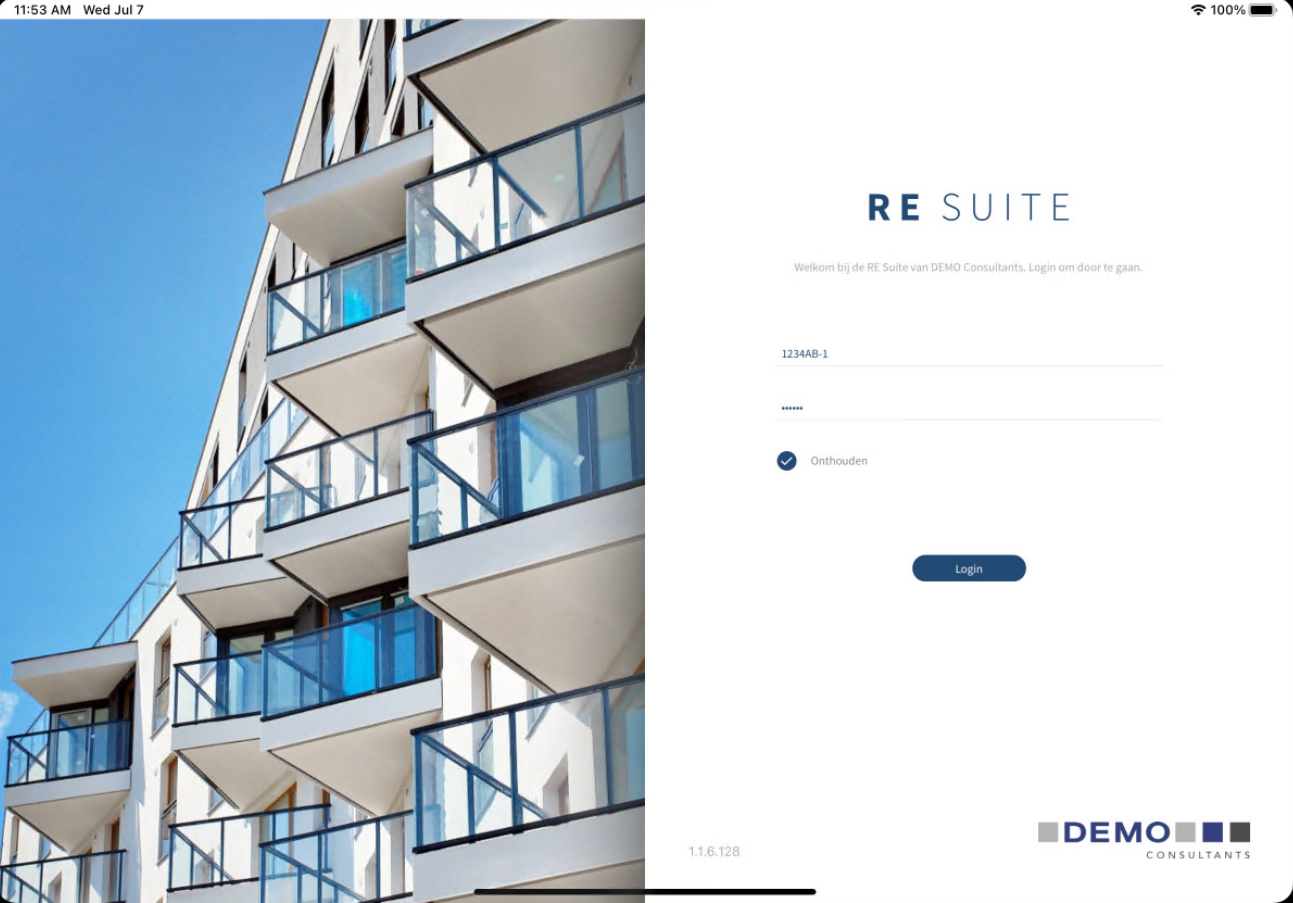- No results found
- Use cases
- Co-Creation Space
Community
Organizations
Collaboration Partners
- Login
Aim: The “Inhabitant app” was developed to:
Scope: The main benefit of the app is during the design phase by better understanding the as-is situation and the needs of the end user. The app however, can be used during the operation to collect feedback from the users for further evaluation and assessment.
In line with the aim of the BIM-SPEED project, the proposed application will facilitate and speed up the data collection from inhabitants while involving them into the decision-making processes. Several data from different categories of information dealing with objective and subjective matters relevant to the business of deep renovation can be collected by the inhabitants:
This information can be collected at different levels (unit of observation). The unit of observation can differ from the most public unit (building level) to the most private unit (a component within the apartment, e.g. a kitchen).
For each category of interest two different types of questions can be accommodated in the app, namely:
1) spatial questions; such questions are pertained to a specific space (e.g. a room). For example, "Please select your kitchen in the BIM model." In this case, all the collected response is a global unique identifier (GUID) of that specific room which can be used for further analyses. This is achieved by implementing a BIM model in the app, which enables inhabitants to select a specific room or a component while replying to the set of questions. The next question would be “how do you find the acoustic comfort of this room?" The result collected is the answer which will be related to the GUID during the analysis.
2) non spatial questions; such questions are not pertained to a specific space. For example,” what is your yearly maintenance cost?”. An upload functionality will enable a user to provide additional material.
An interactive BIM viewer is implemented in the app to facilitate the communication of spatial questions. Inhabitants can indicate a space in response to a question.
To propose and develop optimized renovation solutions, a good understanding of the as-is situation of a building as well as the needs and requirements of the prospective inhabitants is required. Inhabitants’ inputs are crucial to complement a set of analyses and simulation results particularly concerning comfort. In this respect, a user-friendly application is developed to collect such input from inhabitants. This has been achieved by firstly identifying the cases that require inhabitants’ inputs for further analyses, simulations, validations, or calibrations. After the identification of relevant cases, a set of questions has been gathered and implemented in a user-friendly app taking privacy and data protection protocols into consideration. The main use case of developing this app is to optimize and digitize the process of data collection and data analysis from the inhabitants.
In line with the objectives of the BIM-Speed Project, the crowd data collection application aims to reduce time, cost and complexity of deploying the tools for data acquisition in residential renovation projects. Additionally, mapping of the data collected amongst various other packages also promotes the inter-operability of the platform.

Similar to any other crowdsourcing platform, the success of the process highly depends on the participation of the targeted group. In any case, the app can be used by a representative who can systematically collect the required data on behalf of the inhabitants.
Future Improvement:
Gamified techniques such as integration of virtual reality (e.g. viewing the renovation designs) can be added to stimulate the participation of the users. Additionally, it can be investigated how the idea of crowdsource data collection can be further utilized by providing inhabitants with simple and easy to use tools.
Advantages:
Advantages of using inhabitant’s app include improved costs, speed, quality, flexibility, scalability, and diversity.
On the server question lists are imported, configured and made ready for distribution towards the relevant participating inhabitants. The mobile device draws upon the question lists and allows inhabitants to fill in relevant information before sending the results to the server. The server then processes these answers and enables a subsequent upload to the BIM-SPEED platform.
More specifically, the Server hosts a (.NET) desktop application, disclosed as Software as a Service (SaaS). Data storage and querying is handled by a server-hosted SQL database. For data exchange with mobile devices the server hosts a REST WebService.
Mobile devices communicate with the webservice for information exchange using internet connectivity. However, required internet connectivity is limited and short term. Normal use of the app requires internet connectivity only for the first login (to verify the user is allowed use of the app) and intentional data exchange, such as checking for updates and submitting completed questionnaire. Beyond these moments, internet connectivity is not required for optimal ease of use.
Question lists and their answers are stored securely in DEMO’s SQL database. Transmission of the data is end-to end encrypted through the HTTPS protocol. On disk the data is encrypted using Transparent Data Encryption (TDE). For the purposes of BIM-SPEED the answers are exportable with the press of a button. This results in the generation of several JSON-documents.
First, a master document contains the sum total of all questions and answers. Second, the questions are ordered in logical groups, with each group’s contents being stored in a separate file.
Filenames identify the relevant postal code, unit number and logical grouping of its contents. Finally, all JSON-documents are uploaded to the BIM-SPEED platform through its connectivity API. Through use of the HTTPS protocol the data stream is end-to-end encrypted.

All documents are licensed as "Creative Commons Attribution-NonCommercial-ShareAlike 4.0 International License" as Attribution - non-commercial distribution - under the same conditions
For further information see: creativecommons

These documents do not claim to be complete. Nor are they to be understood in the sense of a recommendation or guideline that is generally valid from a legal point of view, but are intended to support the client and contractor in applying the BIM method. The use cases must be adapted to the specific project requirements. The examples given here do not claim to be complete. Information is based on practical experience and should therefore be regarded as best practice and not generally applicable.
NOT REGISTERED YET?
Register for the Use Case Management Service for free to start creating your first use case.
Registered users can use the download area and the comment functions.

The overall process for inhabitant data crowdsourcing is presented in the figure below. It is important to highlight the division between the procedures that involve a questionnaire manager, and the processes that involve the inhabitants (participants in the crowdsourcing) as shown in the scheme. Naturally, the inhabitants only interact with the mobile app while setting up and preparing the questions are the responsibility of the questionnaire manager.

Question list preparation by the questionnaire manager
The process starts behind the scenes with the questionnaire manager setting up a real estate object in the RE Suite. The questionnaire manager creates a new real estate object, gives it a name and object number, and optionally can add more general data, like year of construction, pictures, GPS-coordinates, etcetera. After setting up the real estate object, lettable units must be added to it. The lettable units are in fact the dwellings of the inhabitants. The questionnaire manager does this by first downloading an empty excel template from RE Suite, and then for each lettable unit add a row to the template with street name, house number, postal code, and city. The questionnaire manager then imports the file into RE Suite, upon which the lettable units are automatically created.
The lettable units form the basis for the inhabitant user accounts, which can be created automatically as soon as the lettable units have been created. Inhabitant user accounts always follow the convention of being in the form of {postal code}-{house number}. Passwords for the accounts are automatically generated in the process.
Once the inhabitant user accounts are created, the credentials (usernames and passwords) can be exported as a CSV. The questionnaire manager can then put these credentials into personal letters for the inhabitants, which informs them about the crowdsourcing investigation and invites them to participate, along with download instructions for the app. Sending the invitation should be done when all other preparatory steps are completed. Once the real estate object is created the questionnaire manager couples a BIM model to it. Importantly, the BIM model should have been made following two main principals: 1) Each IFCSpace should have address information in its parameters (street name, house number). For details refer to the BIMSpeed BIM-protocol or to the inhabitants-app instructional video. The street name and house number should exactly match the addresses of the lettable units. 2) The BIM model should be exported from the modeling software with SpaceBoundary data. When the BIM model meets all requirements, it can be uploaded to the BIMSpeed platform, and then coupled to the real estate object directly from RE Suite, using a SSO connection with the BIMSpeed platform or alternatively uploaded and coupled locally.
The final preparatory step is to create the questionnaire. The questionnaire manager can download an empty questionnaire template from RE Suite and then define the questions row-by-row in the template. For details, please refer to the detailed instructions in the inhabitants-app video. Once the template is finished, it can be imported into RE Suite.
With the template imported and inhabitant user accounts created, the individual question list ‘instances’ for the inhabitants can be created. This is done in the Planning section of RE Survey. Thereby the questionnaire is ‘released’ for the inhabitants from the given date onward.
Now the questionnaire manager can send the invitational letter to the inhabitants, with in it an invitation to participate, app download instructions and user credentials.
Filling in the questionnaire by the inhabitants
The process now continues with the inhabitants receiving the invitational letter. Assuming they want to participate, they download the mobile app, and make a small configurational setting in the app settings, which allows them to connect to the BIMSpeed environment.
After logging in, all question lists that have been released for the inhabitant are directly available from the home screen and can be selected. If only one question list is available for the inhabitant, it will be automatically selected to be shown.
Once a question list is selected, the inhabitant gets a global overview of the question list, with its themes and the questions inside the themes. The inhabitant can access a question by tapping on it. This leads to a deeper page where the questions can be answered. Once a question is answered the inhabitant can go back to the overview or immediately continue to the next question, which allows to run through the question list quickly.
At any time, the inhabitant can choose to hand in the questionnaire. This is also possible when not all questions are answered. After handing in the questionnaire, data-synchronization with the RE Suite server is automatically prompted. An active internet connection is needed for this.
Working with the results by the questionnaire manager
Questionnaire manager retrieves new synchronization updates automatically when logging in to RE Suite. If desired, additional synchronization commands can be triggered anytime. The questionnaire manager can thereby get an actual overview of the statuses of all released question lists.
Questionnaire manager can look through all individual question lists, see any given answers, and optionally even edit the answers manually. Cross sections can be created over the dataset, for quickly getting different overviews over the data.
Finally, whenever desired, question list results can be exported to the BIMSpeed platform. This creates JSON documents on the platform with all questions and their corresponding responses data in it, which can be accessed by other application to perform further analysis.
The first step to using this tool is to for the questionnaire manager is to create a new real estate object with necessary details to facilitate data collection. The next step involves filling in the leasable units onto the excel template (downloaded from the RE-Suite). From the inhabitants end, the app can be downloaded from application stores and then the configuration is connected to BIM-Speed servers and questionnaires. The users login with a unique username and need to confirm to the user content to begin with answering the questionnaire.

As a pre-requisite for the development of the questionnaire for the leasable unit, the following are required:
The overall feasibility of using this tool has been observed based as:
As mentioned in the limitations section of the Use-Case document, the process highly depends on the participation of the targeted inhabitants group. This application can also be used by a representative collecting required data from inhabitants, to efficiently compile the results.